No wonder that Formatville's motto is:
"Live by its 10 commandments or" - like Donnie Brasco would say - "Fuhgeddaboudit"
So if you want YOUR screenplay to be read and not tossed, apply these script formatting guidelines. Today the sixth commandment.
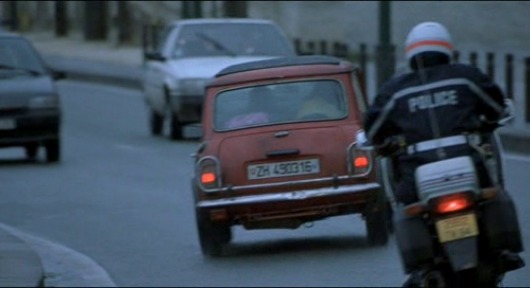
We asked our format expert, Matt, aka Formatman, to lead us through the 10 screenplay formatting commandments.
If you missed the introduction to this series of articles, you may want to check it out first.
Here is the link to Part 1, where it all started.
Whatascript:
Formatman, what is this screenplay formatting commandment about?
Formatman:
Cars!
Why? simply because most movies have car scenes and it's important to get their screenplay format right.
Whatascript:
What will you cover?
Formatman:
First the basic car situations and when to use them.
Then some specific car scenes you often see in movies and may wonder what their screenplay format is. For example:
Formatman:
First, the basics!
Ask yourself. Where do you want to put the focus of the reader?
Your answer to this question determines how to write the car scene.
There are basically 2 reasons to do that:
In both cases the car is part of the Exterior set.
In terms of screenplay format, the master scene heading starts therefore with EXT.
This is the beginning of a draft version of Gone in 60 seconds, screenplay written by Scott Rosenberg.
This scene got edited later on, but it illustrates the point:
In this example the car is even introduced as a secondary master heading to put emphasis on it.
EXT. LONG BEACH STREET - LOWER GRAND - NIGHT The streets are empty. Low fog skims the sidewalks below a gray stew of a sky. It's slightly fuzzy, slightly surreal. The vast Port of Los Angeles is visible in the b.g... No cars parked here ... No cars except - A '67 SHELBY MUSTANG GT-500Silver with deep grill, its sculptured side panels ending in air scoops ... All cock and balls, it stands alone in the lonely cool before dawn ... An old-school totem to speed and style... 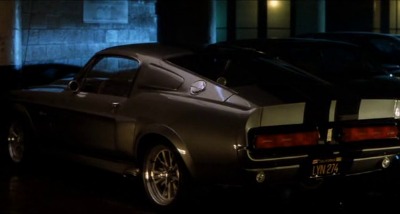
There are again basically 2 reasons to do that:
In both cases, the character watches the outside world through the window and often in thrillers / crime / action movies through binoculars.
The car is then considered as an Interior set. The master scene heading starts therefore with INT.
This is an extract from 8MM, screenplay written by Andrew Kevin Walker.
INT. WELLES' CAR -- NIGHT Welles still watches the house. There's a light on in one of the second floor windows, curtains closed. Welles yawns, shaking his head, trying to stay awake. At the quaint house, a light comes on in the front picture window. Looks like a living room or dining room. The old woman comes to sit at a table. Welles takes binoculars off the front seat... THROUGH BINOCULARS The old woman says something to someone we cannot see.
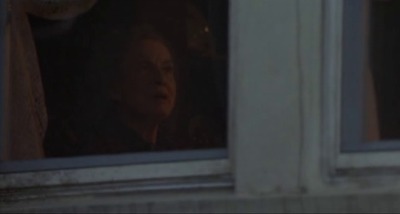
In above examples the cars were parked. If the car is moving you use the following screenplay format:
The first 2 examples are from The Italian Job, screenplay written by Donna Powers and Wayne Powers.
The last 2 examples are from The Bourne Ultimatum, screenplay written by Tony Gilroy, Scott Z. Burns and George Nolfi.
We usually first see the car in its environment, then we switch to the occupant(s) of the car and the action taking place in the car.
There are 2 common screenplay formats to show that:
In this case the screnplay format will usually start with EXT. showing the car and follow with INT. to take care of the action inside of the car.
This is an extract from Babel, screenplay written by Guillermo Arriaga.
EXT. DESERT -- DAY The Moroccan police trucks drive down the dusty roads. The landscape is harsh and barren.INT. POLICE TRUCK -- DAY Hassan's wife gives directions. WIFE Make a right here. Alarid, with his hand, signals the driver to follow her directions. Suddenly, in the distance, over the hills, she signals three tiny dots running up a slope. WIFE (CONT'D) That's them.
ALARID (To the driver) Stop... The trucks stop and Alarid takes out his binoculars. P.O.V. ALARID'S BINOCULARS -- CONTINUOUS In the distance, we can still see Abdullah, Yussef and Ahmed run across the hills. Abdullah is clearly carrying the rifle.
Side notes on binoculars and POV:
If one of the characters was to speak while watching through his binoculars his name in the dialogue part would be followed by (O.S.), which means OFF SCREEN.
Why? because he's at the scene location but not in the camera frame. We would hear him, but not see him, since we see what he sees through his binoculars.
The screenplay format in this case uses INT./EXT. or EXT./INT. depending on whether the scene starts inside or outside the car.
Doing so ties both the INT. and EXT. scenes together as if they intertwined.
This is an example from Drive, screenplay written by Hossein Amini.
INT/EXT. IMPALA/ ELECTRONICS SUPERSTORE/ DOWNTOWN - NIGHT Driver reaches under the seat and pulls out a small handheld scanner. He switches it on, tuning it to the right frequency. Crackling police dispatches are interspersed with the basketball commentary now. POLICE SCANNER ...9 Adam 81, what is your current location?...Repeat, what is your current location?... BASKETBALL COMMENTARY ...Another unbelievable three pointer from Davis and the Clippers are within five!... Out of the corner of his eye Driver sees two MEN approach. He doesn't react, expecting them. They cut through the fence with bolt cutters and approach the main building. Driver watches them pull on their masks, then one of them takes out a shotgun and blasts the lock to the front door. Instantly the alarm shrills. The only thing Driver does is to turn on his stop watch.BASKETBALL COMMENTARY ...Time out Knicks... The stop watching keeps ticking away, the siren blaring, the commentary continuing, the police scanner crackling. The storefront is hidden in shadow, impossible to tell what's going on inside. Driver looks at his stop watch. Almost three minutes. One of the masked men emerges now, carrying a duffel bag.
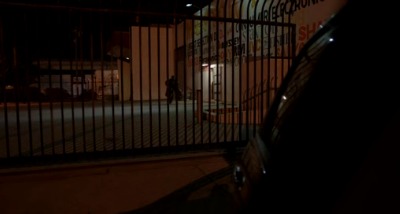
For more use of INT./EXT. in non car related scenes, see 2nd formatting commandment: "Thou shalt not let the reader get lost"
Whatascript:
Shall we now cut to the chase?
Formatman:
Definitely. Now that we have gone through the basics we can go through specific situations, starting with car chases.
There are different ways to write them in terms of screenplay format.
Let's go through two of them:
In this example from Basic Instinct, written by Joe Eszterhas, the screenplay format uses basically two master scene headings (INT. PORSCHE and EXT. THE STREETS) and keeps switching between them.
We get to see the actions of the main character, Nick Curran, from inside his Porsche. And we follow the chase he has with a Ferrari, which nearly ran him over, from the outside.
INT. THE PORSCHE The Ferrari is up ahead and makes a wild right turn onto a road going up a hillside. He yanks the wheel hard. EXT. THE STEPS The Porsche rockets up the steps -- bouncing high into the air, almost out of control. INT. THE PORSCHE As it crests the steps and gets to the street. Nick GUNS it and it looks like it flies high down the hill-side into blackness. EXT. THE STREET But it lands on more steps -- heading downward -- bucking, almost spinning, it bounces onto the next street. INT. THE PORSCHE Another set of steps leading up he GUNS it, it rockets up, ROARS, bucking -- EXT. THE STREET And lands on the next street. Nick makes a wild right turn onto the street. And the black Ferrari appears from around a curve to the right, heading right for him. INT. THE PORSCHE Nick steps on the GAS and heads head-on for the Ferrari. The Ferrari SCREAMS head-on for him.EXT. THE STREET And at the last moment, in the game of chicken, the Ferrari tries to swerve around him on this narrow road, goes out of control and over the side, turning over and over as it rolls down the hillside.
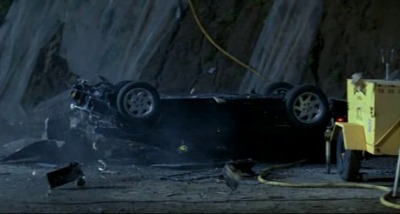
Another way to write such a scene in terms of screenplay format is to use secondary scene headings within an extended scene line.
Each character or main object in the scene gets to be written as a secondary scene heading. And from time to time a new extended scene line
This is an example from The Bourne Supremacy, screenplay written by Tony Gilroy.
INT./EXT. MOSCOW STREETS/CARS/FACES -- DAY THE CAB speeding across A BOULEVARD into an older neighborhood of rising narrow streets and --TWO MOSCOW POLICE CARS PULLING U-TURNS on the BOULEVARD -- whipping around to give chase and -- THE G-WAGON in full pursuit now and -- BOURNE DRIVING -- up this curving little hill and --
THE TWO MOSCOW POLICE CARS starting to climb and -- KIRILL DRIVING and he's on the hill now -- BOURNE -- bad hand on the wheel -- holding on -- trying to find something in passenger seat -- TUBE SOCKS? THE TWO MOSCOW POLICE CARS splitting up! -- one on Bourne's ass -- the other cutting hard into A SIDE STREET, flanking him and -- BOURNE -- topping the hill -- two choices -- right or left?
Sounds familiar? you watch a movie and suddenly wonder: how's the screenplay format of that scene?
Well, wonder no more, and click to find out about the Top 6 Common Car Actions.
Whatascript:
This concludes this this article on the 6th screenplay formatting commandment: Thou shalt cut to the chase.
Thank you, Formatman.
Formatman:
May the Format be with you!


You may not realize it but by taking this simple action you
empower us to write more articles like that - one Comment/Like/Share at a time.
Thanks for that.
Pictures and screenplay extracts:
-- "The Bourne Identity" - Matt Damon (Bourne), Tony Gilroy and W. Blake Herron (screenplay), Doug Liman (director), Oliver Wood (director of Photography)
-- "Gone in 60 seconds" - Scott Rosenberg (screenplay), Dominic Sena (director), Paul Cameron (director of Photography)
-- "8MM" - Andrew Kevin Walker (screenplay), Joel Schumacher (director), Robert Elswit (director of photography)
-- "The Italian Job" - Donna Powers and Wayne Powers (screenplay)
-- "The Bourne Ultimatum" - Tony Gilroy and Scott Z. Burns and George Nolfi (screenplay), Paul Greengrass (director), Oliver Wood (director of Photography)
-- "Babel" - Ehou Mama (wife), Guillermo Arriaga (screenplay), Alejandro Gonzalez Inarritu (director), Rodrigo Prieto (director of Photography)
-- "Drive" - Hossein Amini (screenplay), Nicolas Winding Refn (director), Newton Thomas Sigel (director of Photography)
-- "Basic Instinct" - Joe Eszterhas (screenplay), Paul Verhoeven (director), Jan de Bont (director of Photography)
-- "The Bourne Supremacy" - Matt Damon (Bourne), Tony Gilroy (screenplay), Paul Greengrass (director), Oliver Wood (director of Photography)
Go from Screenplay Format to Whatascript! Home page
* Avatar, screenplay written by James Cameron